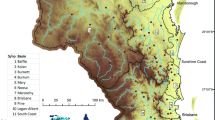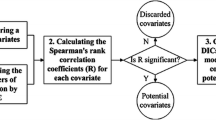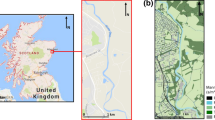Abstract
A probabilistic flood risk modelling chain is proposed for flood risk analysis with consideration of spatial spreading and temporal clustering of the flood events. The proposed method consists of (1) a continuous simulation of long-term climatic and hydrologic fields, (2) Monte-Carlo simulations of a 1D river and inundation model and (3) a probabilistic loss model. In the first stage, three multisite multivariate weather generators were tested and a K-nearest neighbor weather generator (KNN-CAD v4) was found most suitable to reproduce hydrological extremes. The methodology was then applied to identify variations in risk between spatially coherent and simplified event sets generated from 5000 years of synthetic data across four river basins in Uttarakhand, India. The results showed that preserving the spatial coherency of regional events lead to a spreading of the T-year local event distributions on both sides of a uniform regional T-year return period. The specificity of the exposure and the correlations between local events translated into minimal (4%) differences in losses at high return periods (> 50 year) but larger difference (20%) at low return periods (5 to 10-year). The redistribution of loss frequencies led to negligible differences in the Annual Average Losses between the different event sets. In this application, a simplified event set structure with uniform but appropriate T-year return periods proved to capture reasonably well the averaged risk metrics regionally. This study illustrates the complexity of estimating regional flood risk accumulation and exemplifies how a probabilistic risk model chain with continuous simulation can provide a more detailed picture of flood risks.
Similar content being viewed by others
References
American Society of Civil Engineers (1996) Hydrology handbook, 2nd edn. ASCE, Reston
Bannayan M, Hoogenboom G (2008) Weather analogue: a tool for real-time prediction of daily weather data realizations based on a modified k-nearest neighbor approach. Environ Model Softw 23(6):703–713
Bárdossy A (2007) Calibration of hydrological model parameters for ungauged catchments. Hydrol Earth Syst Sci Discuss 11(2):703–710
Bookhagen B, Burbank DW (2006) Topography, relief, and TRMM-derived rainfall variations along the Himalaya. Geophys Res Lett 33(8):L08405
Breinl K, Turkington T, Stowasser M (2013) Stochastic generation of multi-site daily precipitation for applications in risk management. J Hydrol 498:23–35
Breinl K, Turkington T, Stowasser M (2015) Simulating daily precipitation and temperature: a weather generation framework for assessing hydrometeorological hazards. Meteorol Appl 22(3):334–347
Breinl K, Di Baldassarre G, Lopez MG, Hagenlocher M, Vico G, Rutgersson A (2017) Can weather generation capture precipitation patterns across different climates, spatial scales and under data scarcity? Sci Rep 7(1):5449
Brissette FP, Khalili M, Leconte R (2007) Efficient stochastic generation of multi-site synthetic precipitation data. J Hydrol 345(3–4):121–133
Buishand TA, Brandsma T (2001) Multisite simulation of daily precipitation and temperature in the Rhine basin by nearest-neighbor resampling. Water Resour Res 37(11):2761–2776
Carreau J, Bouvier C (2016) Multivariate density model comparison for multi-site flood-risk rainfall in the French Mediterranean area. Stoch Environ Res Risk Assess 30(6):1591–1612
Chen J, Brissette FP, Zhang XJ (2014) A multi-site stochastic weather generator for daily precipitation and temperature. Trans ASABE 57(5):1375–1391
Chen J, Brissette FP, Zhang XJ (2015) Hydrological modeling using a multisite stochastic weather generator. J Hydrol Eng 21(2):04015060
Chow V (1959) Open channel hydraulics. McGraw-Hill, New York
Clark MP, Gangopadhyay S, Brandon D, Werner K, Hay L, Rajagopalan B, Yates D (2004) A resampling procedure for generating conditioned daily weather sequences. Water Resour Res 40(4):W04304
Coles S (2001) An introduction to statistical modeling of extreme values. Springer, London
Das PK (2013) The Himalayan Tsunami”–Cloudburst, flash flood & death toll: a geographical postmortem. IOSR J Environ Sci Toxicol Food Technol 7:33–45
Dee DP, Uppala SM, Simmons AJ, Berrisford P, Poli P, Kobayashi S et al (2011) The ERA-Interim reanalysis: configuration and performance of the data assimilation system. Q J R Meteorol Soc 137(656):553–597
Dhar ON, Nandargi S (2004) Rainfall distribution over the Arunachal Pradesh Himalayas. R Meteorol Soc Weather 59(6):155–157
DHI (2017) M11, a modelling system for rivers and channels. Reference manual. DHI Water & Environment, Hørsholm
DHI, ERN, AIT Joint Venture (2017) Typologies, vulnerability functions and costs applied in the DRA. Technical Project Report (Component 2, Output 1). Uttarakhand Disaster Recovery Project, India
European Commission (2007) Directive 2007/60/EC of the European Parliament and of the Council of 23 October 2007 on the assessment and management of flood risks. Official Journal of the European Union
Evaluación de Riesgos Naturales América Latina-ERN-AL (2009a) Vulnerabilidad de edificaciones e infraestructura. Tomo I—Metodologia de Modelacion Probabilistica de Riesgos Naturales. Informe Técnico ERN-CAPRA-T1-5. https://ecapra.org. Accessed 31 Oct 2018
Evaluación de Riesgos Naturales América Latina-ERN-AL (2009b) Metodo de Analisis Probabilista del Riesgo. Tomo I—Metodologia de Modelacion Probabilistica de Riesgos Naturales. Informe Técnico ERN-CAPRA-T1-6. https://ecapra.org. Accessed 31 Oct 2018
Evaluación de Riesgos Naturales América Latina-ERN-AL (2011) CAPRA-GIS v2.0. Program for the probabilistic risk assessment. https://ecapra.org. Accessed 31 Oct 2018
Evin G, Favre AC, Hingray B (2018) Stochastic generation of multi-site daily precipitation focusing on extreme events. Hydrol Earth Syst Sci 22(1):655
Falter D, Schröter K, Dung NV, Vorogushyn S, Kreibich H, Hundecha Y, Merz B (2015) Spatially coherent flood risk assessment based on long-term continuous simulation with a coupled model chain. J Hydrol 524:182–193
Funk C, Peterson P, Landsfeld M, Pedreros D, Verdin J, Shukla S et al (2015) The climate hazards infrared precipitation with stations—a new environmental record for monitoring extremes. Sci Data 2:150066
Ghizzoni T, Roth G, Rudari R (2012) Multisite flooding hazard assessment in the Upper Mississippi River. J Hydrol 412:101–113
Ghosn M, Moses F, Wang J (2003) NCHRP report: design of highway bridges for extreme events. Transportation Research Board of the National Academics, Washington
Grimaldi S, Petroselli A, Arcangeletti E, Nardi F (2013) Flood mapping in ungauged basins using fully continuous hydrologic–hydraulic modeling. J Hydrol 487:39–47
Haberlandt U, Radtke I (2014) Hydrological model calibration for derived flood frequency analysis using stochastic rainfall and probability distributions of peak flows. Hydrol Earth Syst Sci 18(1):353–365
Hong Y, Adler RF (2008) Estimation of global SCS curve numbers using satellite remote sensing and geospatial data. Int J Remote Sens 29(2):471–477
Horritt MS, Bates PD (2002) Evaluation of 1D and 2D numerical models for predicting river flood inundation. J Hydrol 268(1):87–99
Hosking JRM, Wallis JR (2005) Regional frequency analysis: an approach based on L-moments. Cambridge University Press, Cambridge
Hou AY, Kakar RK, Neeck S, Azarbarzin AA, Kummerow CD, Kojima M et al (2014) The global precipitation measurement mission. Bull Am Meteorol Soc 95(5):701–722
Huizinga J, Moel H de, Szewczyk W (2017) Global flood depth-damage functions. Methodology and the database with guidelines. JRC Working Papers JRC105688. Joint Research Centre, Seville
Hundecha Y, Merz B (2012) Exploring the relationship between changes in climate and floods using a model-based analysis. Water Resour Res 48(4):W04512
Hundecha Y, Zehe E, Bárdossy A (2002) Regional parameter estimation from catchment properties for the prediction of ungauged basins. In: Proceedings of the PUB Kick-off meeting, pp 20–22
Hundecha Y, Pahlow M, Schumann A (2009) Modeling of daily precipitation at multiple locations using a mixture of distributions to characterize the extremes. Water Resour Res 45(12):W12412
Iman RL, Conover WJ (1982) A distribution-free approach to inducing rank correlation among input variables. Commun Stat Simul Comput 11(3):311–334
Jongman B, Hochrainer-Stigler S, Feyen L, Aerts JC, Mechler R, Botzen WW et al (2014) Increasing stress on disaster-risk finance due to large floods. Nat Clim Change 4(4):264
Khalili M, Brissette F, Leconte R (2009) Stochastic multi-site generation of daily weather data. Stoch Environ Res Risk Assess 23(6):837–849
King LM, McLeod AI, Simonovic SP (2015) Improved weather generator algorithm for multisite simulation of precipitation and temperature. JAWRA J Am Water Resour Assoc 51(5):1305–1320
Kron W (2005) Flood risk = hazard• values• vulnerability. Water Int 30(1):58–68
Kumar V (2017) Statistical distribution of rainfall in Uttarakhand, India. Appl Water Sci 7(8):4765–4776
Kundzewicz ZW, Pińskwar I, Brakenridge GR (2013) Large floods in Europe, 1985–2009. Hydrol Sci J 58(1):1–7
Leander R, Buishand TA (2007) Resampling of regional climate model output for the simulation of extreme river flows. J Hydrol 332(3–4):487–496
Lu Y, Qin XS (2014) A coupled K-nearest neighbour and Bayesian neural network model for daily rainfall downscaling. Int J Climatol 34(11):3221–3236
Luo P, He B, Takara K, Xiong Y, Nover D, Duan W, Fukushi K (2015) Historical assessment of Chinese and Japanese flood management policies and implications for managing future floods. Environ Sci Policy 48:265–277
Luo P, Apip B He, Duan W, Takara K, Nover D (2018a) Impact assessment of rainfall scenarios and land-use change on hydrologic response using synthetic Area IDF curves. J Flood Risk Manag 11(S1):84–97
Luo P, Mu D, Xue H, Ngo-Duc T, Dang-Dinh K, Takara K, Nover D, Schladow G (2018b) Flood inundation assessment for the Hanoi Central Area, Vietnam under historical and extreme rainfall conditions. Sci Rep 8(1):12623
Madsen H (2000) Automatic calibration of a conceptual rainfall–runoff model using multiple objectives. J Hydrol 235(3–4):276–288
Mandal S, Breach P, Gaur A, Simonovic S (2017) Tools for downscaling climate variables: a technical manual. Water resources research report no. 097. Department of Civil and Environmental Engineering, Western University, Canada
Marulanda MC, Carreno ML, Cardona OD, Ordaz MG, Barbat AH (2013) Probabilistic earthquake risk assessment using CAPRA: application to the city of Barcelona, Spain. Nat Haz 69(1):59–84
Merz B, Hall J, Disse M, Schumann A (2010) Fluvial flood risk management in a changing world. Nat Hazard Earth Syst 10(3):509
Meyer V, Haase D, Scheuer S (2009) Flood risk assessment in European river basins—concept, methods, and challenges exemplified at the Mulde river. Integr Environ Assess Manag 5(1):17–26
Neal J, Keef C, Bates P, Beven K, Leedal D (2013) Probabilistic flood risk mapping including spatial dependence. Hydrol Process 27(9):1349–1363
Nielsen SA, Hansen E (1973) Numerical simulation of the rainfall runoff process on a daily basis. Nordic Hydrol 4:171–190
Oliver J, Qin XS, Larsen O, Meadows M, Fielding M (2018) Probabilistic flood risk analysis considering morphological dynamics and dike failure. Nat Hazards 91(1):287–307
Pai DS, Sridhar L, Rajeevan M, Sreejith OP, Satbhai NS, Mukhopadhyay B (2014) Development of a new high spatial resolution (0.25 × 0.25) long period (1901–2010) daily gridded rainfall data set over India and its comparison with existing data sets over the region. Mausam 65(1):1–18
Parida BR, Behera SN, Bakimchandra O, Pandey AC, Singh N (2017) Evaluation of satellite-derived rainfall estimates for an extreme rainfall event over Uttarakhand, Western Himalayas. Hydrology 4(2):22
Prakash S, Mitra AK, Pai DS, Kouchak A (2016) From TRMM to GPM: how well can heavy rainfall be detected from space? Adv Water Resour 88:1–7
Rana N, Singh S, Sundriyal YP, Juyal N (2013) Recent and past floods in the Alaknanda valley: causes and consequences. Curr Sci 105(9):1209–1212
Rawls WJ, Brakensiek DL (1989) Estimation of soil water retention and hydraulic properties. Unsaturated flow in hydrologic modeling. Springer, Dordrecht, pp 275–300
Reese S, Ramsay D (2010) RiskScape: flood fragility methodology. National Institute of Water and Atmospheric Research, Wellington, p 42
Rulin O, Liliang R, Weiming C, Zhongbo Y (2008) Application of hydrological models in a snowmelt region of Aksu River Basin. Water Sci Eng 1(4):1–13
Salgado-Gálvez MA, Zuloaga-Romero D, Bernal GA, Mora MG, Cardona OD (2014) Fully probabilistic seismic risk assessment considering local site effects for the portfolio of buildings in Medellín, Colombia. Bull Earthq Eng 12(2):671–695
Schneeberger K, Huttenlau M, Winter B, Steinberger T, Achleitner S, Stötter J (2017) A probabilistic framework for risk analysis of widespread flood events: a proof-of-concept study. Risk Anal 39(1):125–139
Serinaldi F, Kilsby CG (2017) A blueprint for full collective flood risk estimation: demonstration for European river flooding. Risk Anal 37(10):1958–1976
Sharma A, Lall U (1999) A nonparametric approach for daily rainfall simulation. Math Comput Simul 48(4–6):361–371
Shepard D (1968) A two-dimensional interpolation function for irregularly-spaced data. In: Proceedings of the 1968 23rd ACM national conference. ACM, pp 517–524
Soille P, Vogt J, Colombo R (2003) Carving and adaptive drainage enforcement of grid digital elevation models. Water Resour Res 39(12):1366
Sparks NJ, Hardwick SR, Schmid M, Toumi R (2018) IMAGE: a multivariate multi-site stochastic weather generator for European weather and climate. Stoch Environ Res Risk Assess 32(3):771–784
Thieken AH, Apel H, Merz B (2015) Assessing the probability of large-scale flood loss events: a case study for the river Rhine, Germany. J Flood Risk Manag 8(3):247–262
Timonina A, Hochrainer-Stigler S, Pflug G, Jongman B, Rojas R (2015) Structured coupling of probability loss distributions: assessing joint flood risk in multiple river basins. Risk Anal 35(11):2102–2119
Unphon H (2009) Re-engineering for evolvability. Dissertation, IT University of Copenhagen
Vallam P, Qin XS (2016) Multi-site rainfall simulation at tropical regions: a comparison of three types of generators. Meteorol Appl 23(3):425–437
Velásquez CA, Cardona OD, Mora MG, Yamin LE, Carreño ML, Barbat AH (2012) Hybrid loss exceedance curve (HLEC) for disaster risk assessment. Nat Haz 72(2):455–479
Wang L, Liu HL, Bao AM, Pan XL, Chen X (2016) Estimating the sensitivity of runoff to climate change in an alpine-valley watershed of Xinjiang, China. Hydrol Sci J 61(6):1069–1079
Ward PJ, De Moel H, Aerts JCJH (2011) How are flood risk estimates affected by the choice of return-periods? Nat Hazards Earth Syst 11(12):3181
Watkins DS (2010) Fundamentals of matrix computations, vol 64. Wiley, New York
Wilks DS (1998) Multisite generalization of a daily stochastic precipitation generation model. J Hydrol 210(1–4):178–191
Wit MJM, Buishand TA (2007) Generator of rainfall and discharge extremes (GRADE) for the Rhine and Meuse basins. Rijkswaterstaat RIZA report 2007.027/KNMI publication 218, Lelystad, The Netherlands
Yates D, Gangopadhyay S, Rajagopalan B, Strzepek K (2003) A technique for generating regional climate scenarios using a nearest-neighbor algorithm. Wat Resou Res 39(7):WR001769
Acknowledgements
The study was funded by the Economic Development Board (EDB) of Singapore (IPP Scholarship) and the DHI-NTU Research Centre and Education Hub. The work is closely affiliated with the Disaster Risk Assessment of Uttarakhand, an initiative of the Uttarakhand Disaster Recovery Programme (UDRP) funded by the World Bank. The findings and conclusions contained within are those of the authors and do not necessarily reflect positions or policies of the World Bank or the UDRP. The authors acknowledge the support of the UDRDP leadership team. Special thanks are directed to Mr. Amit Singh Negi, Program Director, and Dr. Girish Chandra Joshi of the UDRP for their support and kind permission to share the outcomes of our work in the public domain. This work directly complements their extensive risk mitigation programme in Uttarakhand.
Author information
Authors and Affiliations
Corresponding author
Additional information
Publisher's Note
Springer Nature remains neutral with regard to jurisdictional claims in published maps and institutional affiliations.
Rights and permissions
About this article
Cite this article
Oliver, J., Qin, X.S., Madsen, H. et al. A probabilistic risk modelling chain for analysis of regional flood events. Stoch Environ Res Risk Assess 33, 1057–1074 (2019). https://doi.org/10.1007/s00477-019-01681-3
Published:
Issue Date:
DOI: https://doi.org/10.1007/s00477-019-01681-3












